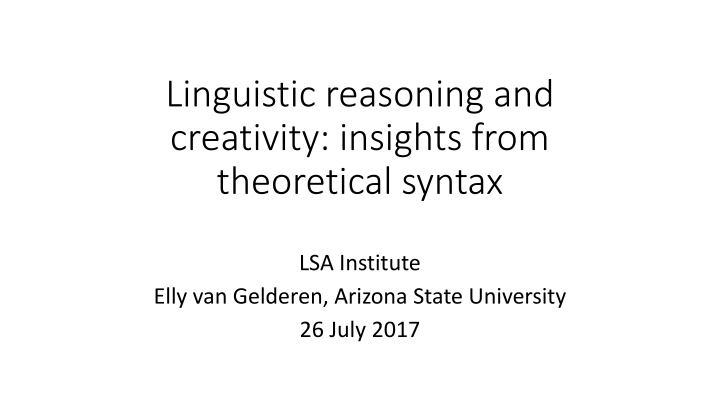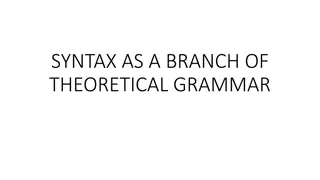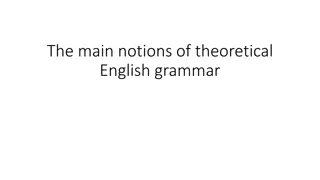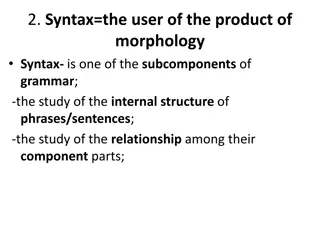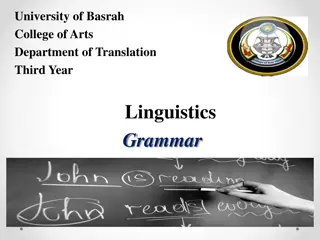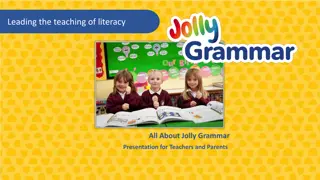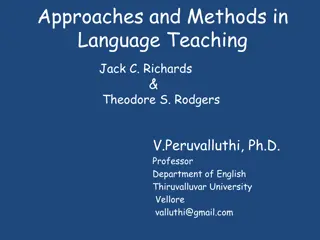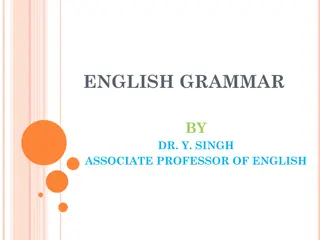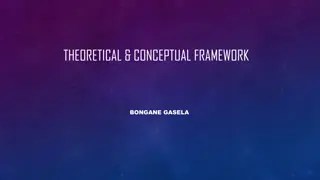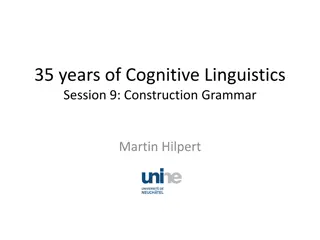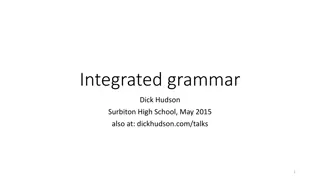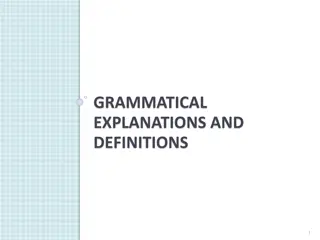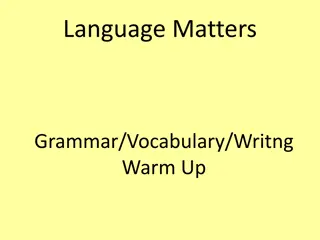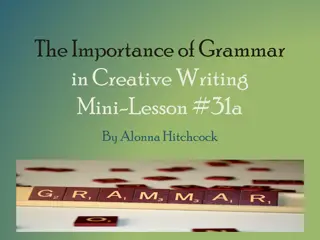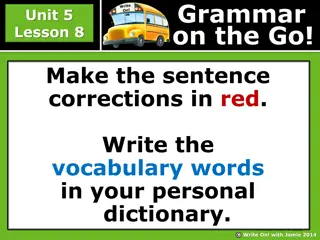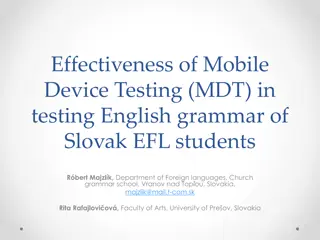Theoretical Insights on Teaching Grammar
Theoretical underpinnings of teaching grammar and creating effective approaches without getting lost in abstract concepts. Delve into generative grammar, syntactic theory, and linguistic creativity for practical applications in language education.
Download Presentation

Please find below an Image/Link to download the presentation.
The content on the website is provided AS IS for your information and personal use only. It may not be sold, licensed, or shared on other websites without obtaining consent from the author.If you encounter any issues during the download, it is possible that the publisher has removed the file from their server.
You are allowed to download the files provided on this website for personal or commercial use, subject to the condition that they are used lawfully. All files are the property of their respective owners.
The content on the website is provided AS IS for your information and personal use only. It may not be sold, licensed, or shared on other websites without obtaining consent from the author.
E N D
Presentation Transcript
Linguistic reasoning and creativity: insights from theoretical syntax LSA Institute Elly van Gelderen, Arizona State University 26 July 2017
From WS description Linguistics is highly theoretical, but many students in grammar courses have little or no linguistics background, and our experience suggests that much current theorizing in the field is not directly applicable. What are (or should be) the theoretical underpinnings of teaching grammar? How can we create an approach to teaching grammar that isn t mired in the theoretical mud, but still accomplishes our goals of accurately representing the complexity of natural language?
Outline What theoretical views are important for grammar? - I-language and creativity - 3 layers (CP, TP, VP) and X -theory - TMA In practice, what does syntactic theory contribute to grammar? - More tolerance - Clausal structure and Parts of Speech - Verb classes and the vP-shell - Discussions on finiteness and Affix-hop
Generative grammar emphasizes I-language: `Mistakes arise through Economy and Efficiency of the learner. Each person s grammar is unique. We need not learn `grammar for judging (1): (1) a. Who did you say that you intend to invite? (adapted COCA fiction 2014) b. *Who did you say when you intend to invite? Creativity: Endless sentences and fun texts, e.g. In Rapid City, S.D., a buffalo escaped from an auction and ended up in a dressing room. It spent a couple of hours staring into a mirror at the Rushmore Plaza Civic Center .
Unique sentences
Specific insights from Syntax (and Typology) A Semantic, Theme, Agent Subject, Object Three different roles: grammatical, pragmatic: Topic and Focus This translates into the vP, TP, CP spine
Clausal spine Pragmatic Layer Grammatical Semantic
Practically Argument versus adverbial regarding the semantic role but X helps too Pragmatic roles: Passive and answers to questions Perhaps some discussion on what unites ditransitive, phrasal, and complex transitive verbs. C(complementizer)P(hrase) S Verb Group VP
B B X Theory X Theory
And more practical grammar uses: complement - modifier
Grammar becomes systematic rather than a list of exceptions
Argumentation around ordering and one (1) A teacher of physics from Macedonia. (2) *A teacher from Macedonia of physics. (3) A Macedonian physics teacher. (4) *A physics Macedonian teacher. (5) The teacher of physics from Latvia and the one from Macedonia. (6) *The teacher of physics from Latvia and the one of math from Macedonia.
NP and VP are similar And same arguments: order and `do so . *teach PP NP *do so physics do so in England
Uniting verbs by vP-shells In grammar, we say (1) is phrasal, (2) complex transitive, and (3) ditransitive. How do we discuss that in the light of vP-shells? (1) (2) (3) I turned it on. I considered it nice. I gave him a book.
TMA and empty categories C Split TP and Cinque s (1999) discussion on where adverbs sit. TMA and linguistic differences: Practically: V-group and discussion about modals etc. D PRO, empty D (=generic), and wh-movement Practically: PRO with non-finites (why?) and movement explains who/m With NP only, no need to explain generic D.
Theoretically: Split TP
And feature -checking
Interim conclusion Take the insights, e.g. creativity, structure, disambiguation. Grammar is rule-based. Use real data and lots of visual help. Do `easy and harder version and say what you expect of them.
Grammars (ENG 314) Major Objectives Be able to label categories Analyze sentences structurally (NP/Subject, etc, embedded CP/Object) Be able to argue why e.g. a word is an Adj and not an Adv Compare the syntax of two texts in `complexity With: Loads of practice Authentic texts Keeping a goal in mind, e.g. forensic linguistics, their own analysis, to write better Encourage comprehensive review sheet
Most students (continue to) struggle with categories How to address that? Simple rules and sticking to them: D, A, C Determiner vs adjective Explain generic
Rules: The Adjective-Adverb Rule An adjective modifies a noun; an adverb modifies a verb and a degree adverb modifies an adjective or adverb.
Rules and sticking to them The Determiner-Adjective Rule A Determiner points to the noun it goes with or who it belongs to; An Adjective gives background information about the noun. The P/C/A/D Rule A Preposition introduces a noun; a Complementizer introduces a sentence; an Adverb is on its own; and a Determiner points to the noun it goes with and who it belongs to.
This focus on form helps a number of students with, for instance: Tense consistency Verbal agreement and finding the subject Run-on sentences Too many similar structures Varying complementizers and copulas Confidence with adverbs
History helps: (1) Under the colour of a veray peax, whiche is neuertheles but a cloked and furred peax. `Under the color of a true peace, which is nevertheless nothing but a cloaked and furred peace. (Cromwell s 16th century Letters) (2) first I had to watch the accounts and secondly I'm looking at all this stuff for when I start my business. (from a conversation in the BNC Corpus) And discussions:
Modal verbs express possibility, etc In Italian: dovere, volere, potere In English: out of hand! Nine core modals: may might will would can could shall should must Many semi-modals: have to, ought to, want to . They become: hafta, wanna, gonna . Are they adapting to: (1) Syr, in good fayth Y am sory therefor, for and Y had west that ye would a taked so sor Y would nat a wreten so vnto you, nat and I schuld a gette therbey xx nobelys ...
Gonna and wanna are adapting from are going to > gonna, etc = modals: (1) I gonna do it, you gonna, s/he gonna, etc. Alright, so we gonna ask you a long question. (CNN 2015) (2) I wanna, you wanna, s/he wanna, etc. You wanna've seen your face (BNC)
Argumentation is really important What is an Object? Explain ambiguity: They swam [in the pool]. What is a Subject? There entered five people into the room. Provide alternative analyses: Coordination and ditransitives Subject Aux Inversion in sentences with RCs
Give alternatives Swimming in the pool - Sleeping during a meeting Do not go gentle/gently The trouble with copula/linking verbs Coordination Ditransitives Relative clauses
Grammar for TESOL (LIN 522) What is it and why is it relevant? Very much the same answers: creativity, L1 L2, PoS needed, structure is needed Rules and examples/texts History explains a lot of the exceptions: ago, a number of , coupla minutes
Introduction to Syntax (LIN 514) and Advanced Syntax (LIN 614) These emphasize: the clausal spine, the three layers, TMA, the DP, pro-drop/EPP, features. There can be: a justification of generative grammar: I-language emphasis a look-ahead: no trees (Chomsky 2017), phases, no EPP, etc Which a grammar class can t.
How much cartography? Just one class of adverb(ial)? Adjunction or special category?
One last point: Linguistic Cycle? Theoretically: Loss and renewal Spec to head and fewer features in a head Practically: Through these, we discuss Negatives (and concord) Doubling of pronouns Pro-drop in Spanish Split infinitive New complementizers
The Negative Cycle (1) Men ne cunnon secgan to so e ... hwa Man not could tell to truth ... who No man can tell for certain ... who . (Beowulf 50 52) Ne + V > ne + V + noht > V + not (2) (3) (4) He don't care about nothing but his car, rims, money. (COCA spoken) [we] became so engrossed in our game of tetherball that we failed to hear the teacher calling us to return to the classroom. (COCA magazine) I never see him much these days. (meaning I don t see him often these days ) (5)
Grammaticalization How would you like your eggs cooked? Yes!
Prepositions also grammaticalize and hence lexical ambiguity (1) a. The highway to Phoenix b. I didn't expect to find you here. (BNC FPM 899) (2) a. Above them on the balcony terrace, Alina (BNC-FYY 1799) b. and iuunden ene king. r he wes an sl ting and they found the king where he was hunting' (Layamon, Caligula 6139) (3) a. hlynode for hlawe (Beowulf 1120) It made noise before/around the gravehill' b. I would prefer for John to stay in the 250 class. (BNC-ED2 626) (4) a. Ercenberht rixode fter his f der E. ruled after his father' (Parker 640) b. After she'd hung up, she went through into the kitchen. (BNC GWO1402)
Conclusions Linguistic theory is important to grammar: Tolerance and creativity and reasoning: grammar is rule-bound Argument adverbial: defines verbs and dictates structure Clause structure consists of different layers Ambiguity and structure; different underlying structures in each person s I-language Part of speech and language change: gradience in categories
